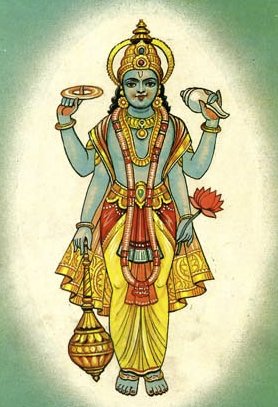Pauganda, Paugaṇḍa, Paugamda: 12 definitions
Introduction:
Pauganda means something in Hinduism, Sanskrit, Marathi. If you want to know the exact meaning, history, etymology or English translation of this term then check out the descriptions on this page. Add your comment or reference to a book if you want to contribute to this summary article.
In Hinduism
Vaishnavism (Vaishava dharma)
Source: Pure Bhakti: Bhajana-rahasya - 2nd EditionPaugaṇḍa (पौगण्ड) refers to:—Boyhood; from age six to ten. (cf. Glossary page from Bhajana-Rahasya).
Source: Pure Bhakti: Brhad BhagavatamrtamPaugaṇḍa (पौगण्ड) refers to:—Boyhood; age six to ten. (cf. Glossary page from Śrī Bṛhad-bhāgavatāmṛta).

Vaishnava (वैष्णव, vaiṣṇava) or vaishnavism (vaiṣṇavism) represents a tradition of Hinduism worshipping Vishnu as the supreme Lord. Similar to the Shaktism and Shaivism traditions, Vaishnavism also developed as an individual movement, famous for its exposition of the dashavatara (‘ten avatars of Vishnu’).
General definition (in Hinduism)
Source: Wisdom Library: HinduismPaugaṇḍa (पौगण्ड) is a Sanskrit word referring to the age from five to ten years.
Languages of India and abroad
Marathi-English dictionary
Source: DDSA: The Molesworth Marathi and English Dictionarypaugaṇḍa (पौगंड).—n S The state of life between childhood and manhood; youth, adolescence.
Source: DDSA: The Aryabhusan school dictionary, Marathi-Englishpaugaṇḍa (पौगंड).—n Youth, adolescence.
Marathi is an Indo-European language having over 70 million native speakers people in (predominantly) Maharashtra India. Marathi, like many other Indo-Aryan languages, evolved from early forms of Prakrit, which itself is a subset of Sanskrit, one of the most ancient languages of the world.
Sanskrit dictionary
Source: DDSA: The practical Sanskrit-English dictionaryPaugaṇḍa (पौगण्ड).—a. (-ḍī f.) Boyish.
-ṇḍam, -paugaṇḍakam Boyhood (from the 5th to the 16th year); भृत्योः पौगण्डके बाला दृष्ट्वोचुर्विस्मिता व्रजे (bhṛtyoḥ paugaṇḍake bālā dṛṣṭvocurvismitā vraje) Bhāgavata 1.12.37.
Source: Cologne Digital Sanskrit Dictionaries: Shabda-Sagara Sanskrit-English DictionaryPaugaṇḍa (पौगण्ड).—f. (-ṇḍī) Boyish. n.
(-ṇḍaṃ) Boyhood, (from the 5th to the 16th year.)
Source: Cologne Digital Sanskrit Dictionaries: Benfey Sanskrit-English DictionaryPaugaṇḍa (पौगण्ड).—i. e. pogaṇḍa + a, I. adj. Proper to boys, boyish, [Bhāgavata-Purāṇa, (ed. Burnouf.)] 3, 31, 28. Ii. n. Boyhood.
Source: Cologne Digital Sanskrit Dictionaries: Monier-Williams Sanskrit-English Dictionary1) Paugaṇḍa (पौगण्ड):—[from pogaṇḍa] a mf(ī)n. relating to a boy, boyish, [Purāṇa]
2) [v.s. ...] n. (also ḍaka) boyhood, a period lasting from the 5th to the 16th year, [Bhāgavata-purāṇa [Scholiast or Commentator]]
3) b ḍaka See pogaṇḍa.
[Sanskrit to German]
Sanskrit, also spelled संस्कृतम् (saṃskṛtam), is an ancient language of India commonly seen as the grandmother of the Indo-European language family (even English!). Closely allied with Prakrit and Pali, Sanskrit is more exhaustive in both grammar and terms and has the most extensive collection of literature in the world, greatly surpassing its sister-languages Greek and Latin.
Kannada-English dictionary
Source: Alar: Kannada-English corpusPaugaṃḍa (ಪೌಗಂಡ):—
1) [adjective] of, like or characteristic of a boy.
2) [adjective] not fit for an adult; immature; silly.
--- OR ---
Paugaṃḍa (ಪೌಗಂಡ):—
1) [noun] the period between the age of five and sixteen of boys.
2) [noun] a boy in this age group.
Kannada is a Dravidian language (as opposed to the Indo-European language family) mainly spoken in the southwestern region of India.
See also (Relevant definitions)
Starts with: Paugandaka, Paukantam.
Ends with: Apauganda.
Full-text: Paugandaka, Poganda, Pongada, Avasthacatushtaya, Apauganda, Paukantam, Apoganda, Apraptavyavahara.
Relevant text
Search found 8 books and stories containing Pauganda, Paugamda, Paugaṃḍa, Paugaṇḍa; (plurals include: Paugandas, Paugamdas, Paugaṃḍas, Paugaṇḍas). You can also click to the full overview containing English textual excerpts. Below are direct links for the most relevant articles:
Bhakti-rasamrta-sindhu (by Śrīla Rūpa Gosvāmī)
Verse 3.3.61 < [Part 3 - Fraternal Devotion (sakhya-rasa)]
Verse 3.4.34 < [Part 4 - Parenthood (vātsalya-rasa)]
Verse 3.3.67 < [Part 3 - Fraternal Devotion (sakhya-rasa)]
Garga Samhita (English) (by Danavir Goswami)
Verse 2.7.1 < [Chapter 7 - Kidnapping of the Calves and Cowherd Boys]
Paugaṇḍa-līlā (Ages 6-10—Pastimes) < [Ādi-khaṇḍa]
Brihad Bhagavatamrita (commentary) (by Śrī Śrīmad Bhaktivedānta Nārāyana Gosvāmī Mahārāja)
Verse 2.1.217 < [Chapter 1 - Vairāgya (renunciation)]
Verse 1.6.73-75 < [Chapter 6 - Priyatama (the most beloved devotees)]
Vasudevavijaya of Vasudeva (Study) (by Sajitha. A)
The concept of Bhakti in Vāsudevavijaya < [Chapter 5 - Impact of other Disciplines in Vāsudevavijaya]
Bhajana-Rahasya (by Srila Bhaktivinoda Thakura Mahasaya)